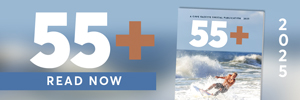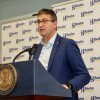Beebe Healthcare encourages everyone to know the signs of stroke
Sometimes, the first signs that someone is experiencing a stroke can be subtle: fatigue, lightheadedness, headaches or tingling sensations.
In other cases, the red flags are serious and clear: sudden loss of vision, slurred speech, intense numbness or weakness, and abrupt confusion.
What’s important to remember is that in all stroke cases, getting medical care as quickly as possible is critical. During National Stroke Awareness Month, remember that “time is brain.”
This is more than a catchy slogan designed to build awareness about stroke response and treatment. It underscores the fact that every single minute counts when a patient is experiencing a stroke. Every minute that passes without adequate blood and oxygen flow to the brain equates to thousands of destroyed brain cells. And that is why it is important to call 911 immediately if you believe you or your loved one is experiencing a stroke.
When emergency responders arrive and assess a stroke patient, they immediately begin collecting and sharing information with us at the hospital so we can prepare for the patient and put plans in place to expedite their care, before they even arrive to the emergency room. These steps cannot take place if the patient comes to the hospital in a personal vehicle and presents in the ER waiting room. We lose valuable minutes, and that greatly impacts a patient’s ability to survive, recover and resume normal functionality following a stroke.
When a 911 call comes in for a potential stroke case, emergency responders are trained to assess patients using a Rapid Arterial Occlusion Evaluation Scale. It prompts them to ask the patient a short list of questions and request a series of actions such as making a fist, lifting their arms and clapping. Their ability or inability to answer and perform these tasks generates a RACE score, which indicates the likeliness of stroke and helps patient care providers understand the steps that need to be taken immediately – both during transit to the hospital and upon arrival to the emergency department.
At Beebe, we follow the industry standard to get a stroke patient from “door-to-needle” in 60 minutes. But we strive to cut down on that time for better outcomes for our patients.
The needle is an injection of tissue plasminogen activator, a clot-busting medication that helps move blood from the body to the brain. It can help minimize brain damage caused by a stroke and increase the likeliness that a patient can partially or fully recover. Beebe is designated as a Primary Stroke Center, which means the hospital has an integrated stroke program staffed by medical professionals who are specially trained in stroke care, with a commitment to delivering individualized patient care focused on education and engagement.
In addition to the great care we provide as a Primary Stroke Center, Beebe is a member of the Thomas Jefferson Neuroscience Network. Beebe has access to the Jefferson Expert Teleconsulting, or JET unit, which is a high-tech mobile robot system for acute stroke. The stroke robot provides 24/7 access to vascular neurologists and neurosurgeons for emergency consultation services. The goal is to complement the care provided by Beebe’s neurologists and/or emergency physicians to those patients presenting with symptoms of a stroke.
The mobile robotic system allows the neurologist to speak directly to the team, the patient and family members via secure videoconference technology. This allows the Jefferson neurologist to gather information and conduct a neurologic examination on the patient. They can also review test results and medical history while on the teleconference. The goal is to make sure the patient receives the appropriate level of care whether they are at Beebe or at Jefferson for the most complex cases.
Beebe has the right systems in place to streamline the process of care for stroke patients and assure they have the best possible outcomes. Education is an important part of what we do, and the message we stress over and over is to not delay getting to the emergency room when signs of stroke present. The quicker you get here, the quicker we can help you and minimize the long-term impact of stroke.
These statistics from last year might be eye-opening for those who might be at risk for stroke.
2021 Stroke Statistics:
63.2% were between 66-85 years old
58.2% had hypertension (high blood pressure)
45.6% had hyperlipidemia (high cholesterol)
29.1% had a previous stroke or transient ischemic attack (TIA)
20.1% had diabetes
14.6% had atrial fibrillation (a-fib).






















































